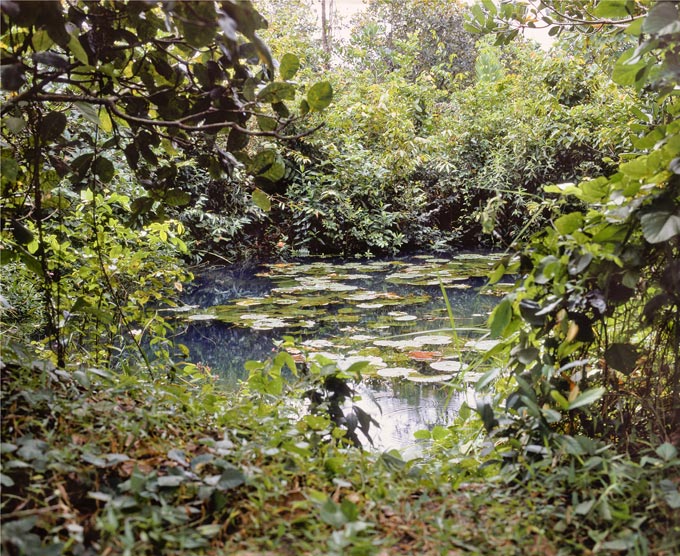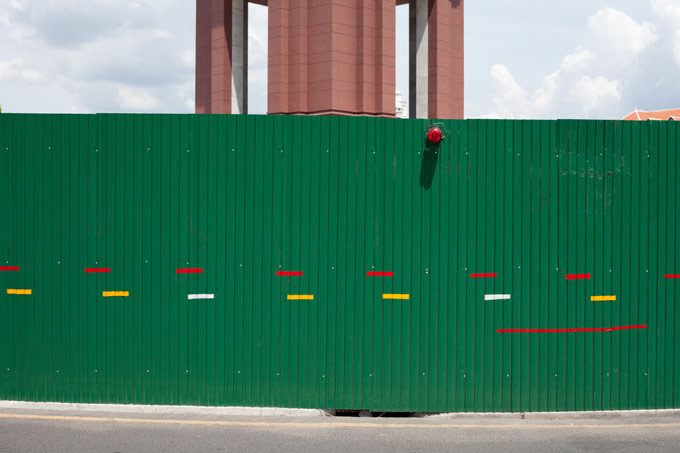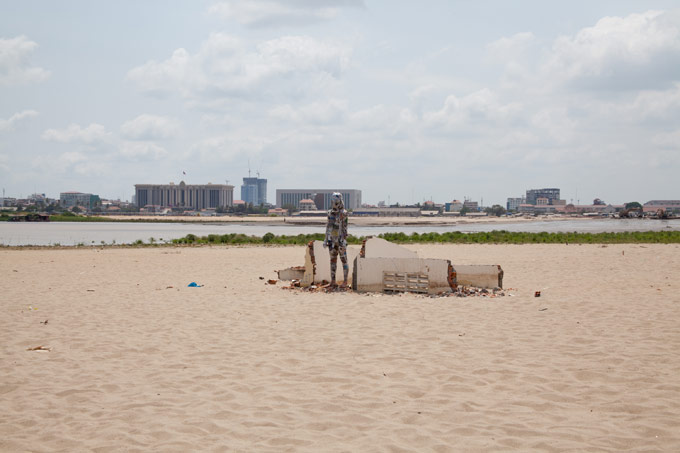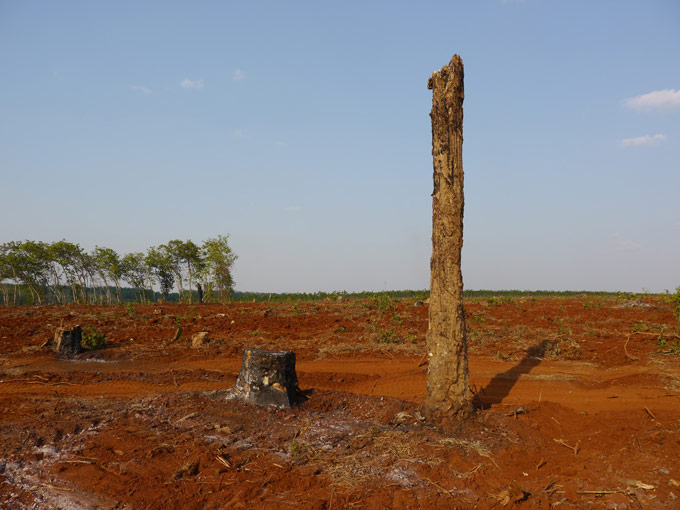Following photography’s invention in the mid-1800s, colonizers and travelers photographed and disseminated images that portrayed Cambodia as an exotic land. It was only at the outset of the Independence years (1953–70) that the country began to record itself, but this practice was interrupted, and its archive mostly destroyed, by war. Concerned by the lack of physical documentation of the stories, traits and monuments specific to the country’s past and present, Cambodian photographers and artists are devising new ways of showing and telling. Below we share a selection of landscape photography, taken in both a literal and symbolic sense, and drawing on historical as well as contemporary events.
Sovan Philong, born 1985

Sovan Philong, Violent Scenes from a Rice Paddy, 2011. Courtesy of the artist and Asia Motion.

Sovan Philong, Violent Scenes from a Rice Paddy, 2011. Courtesy of the artist and Asia Motion.
One early morning in June 2011, 250 villagers of Stock Slat village in Kampong Speu Province took up arms and blocked the path of 300 police officers who had arrived to evict them. Cambodia’s Supreme Court had awarded their 160 acres of farmed rice paddies to a foreign company. The English-language daily that first printed these images reported that concerned residents had stayed up all night to prepare for the eviction, transporting beds and entire houses to block the authorities’ path. The police forced their way through the makeshift barricades. The villagers fought back with whatever tools they could grab, including sticks and farming tools. Blood was shed on both sides. Sovan Philong recorded the events on the front line, risking his safety to capture and share photographic evidence of the conflict. In a political climate where national media are cautious about reporting on land evictions, images such as Sovan’s are particularly important. Often circulated internationally and spread through social media networks, they help to foster engagement with these issues.
*This text has been adapted from a short essay on Sovan Philong by our colleague Vuth Lyno, an artist and curator, with his permission.
Vandy Rattana, born 1980

Vandy Rattana, Kompong Cham, from the series “Bomb Ponds,” 2009

Vandy Rattana, Takeo, from the series “Bomb Ponds,” 2009
“You can hear something a thousand times and not know it; yet if you see it with your eyes just once, you know.” — Khmer proverb
For his acclaimed “Bomb Ponds” series, Vandy Rattana confronted the physical and psychological scars left by the American carpet-bombing of Cambodia, a campaign that lasted from 1965 to 1973 but is largely unknown even within Cambodia. Visiting the ten most affected Cambodian provinces bordering Vietnam, Vandy photographed the craters left by bombs, most of which are now filled with water. Recognizing the contradictions between the violent history and the current serenity of the landscapes, and questioning the photographs’ ability to speak beyond the silence, Vandy interviewed villagers who had lived through the bombing. (The artist presents their stories in a gripping one-channel video accompanying his photo-series.) While “Bomb Ponds” brings attention to the lack of documentation of these unwarranted acts of violence undertaken by the United States, it also pays respect to the resilience of the land and its survivors. The intense distance between experiential, written and oral history provoked a shift in the artist’s beliefs about the relationship between historiography and image making. Following “Bomb Ponds,” for Vandy, photography and history itself became fiction.
Lim Sokchanlina, born 1987

Lim Sokchanlina, Wrapped Future / Phnom Penh. Cambodia. 2012: Olympic Stadium, East side, 2012. Courtesy of the artist.

Lim Sokchanlina, Wrapped Future / Phnom Penh. Cambodia. 2012: Olympic Stadium, East side, 2012. Courtesy of the artist.
With heightened urban construction since 2009, various fences and makeshift enclosures have come to define much of Phnom Penh’s topography. Lim Sokchanlina has been photographing such partitions for over four years with special attention to contentious sites. Concerned with divisive development launched in the name of a “New Phnom Penh,” Lim scrutinizes these newly erected borders, portraying the physical and psychological effects of their separation of public and private, past and future, and the known and unknown. “The land enclosed is no longer a presence, as if what was displaced or destroyed at these sites no longer matters,” the artist declares. “Memory has been traded for development. These fences are wrapping the future, standing in place of what was forgotten or never even known.” Lim’s corrugated color fields flatten the imposing fences into mundane facades. Arrested expanses of color, patterns and markings invite painterly reflections, while his titles record what was where, and when. Isolated from their bustling surroundings and rescued from their impending fate, the fences are photographically preserved as landmarks. The above images document the enclosure of two revered architectural icons by Cambodian architect and urban planner Vann Molyvann: Independence Monument (1958) and Olympic Stadium (1964).
Khvay Samnang, born 1982

Khvay Samnang, Newspaper Man, 2011. Courtesy of the artist.
An alien figure, the titular “Newspaper Man” stands alone in the center of a surreal, light-washed urban landscape: a sand-filled lake in central Phnom Penh. Khvay Samnang has engaged this site many times in recent years; in this iteration, he responded to a historical moment absent in local media reportage with a performance documented by the above photograph and a single-channel video. Blinded by newspapers wrapped around his body, Khvay clumsily walked along a contrived shoreline, tripping over the few remains of the homes lost by thousands of families evicted and relocated from this site. A panorama of developments lines the horizon while excavators are seen at work. As “Newspaper Man,” the artist calls attention not only to the land and its recent history but also to the role of Khmer-language journalism in neglecting to cover a matter of deep environmental, infrastructural and humanitarian concern.
Pete Pin, born 1982

Pete Pin, from the series “Cambodia Diaspora,” 2011. Courtesy of the artist.

Pete Pin, from the series “Cambodia Diaspora,” 2011. Courtesy of the artist.
Part of his ongoing work with the Cambodian diaspora in the United States, the two above images by Cambodian-American photographer Pete Pin show a cautious engagement with space in an attempt to translate his subjects’ stories about “navigating life in the context of the very hard, and at times violent realities of adapting to a new homeland.” A daunting view of a tenement-building row reflects the intimidating landscape of the Bronx as experienced by numerous refugees who relocated there from Cambodian refugee camps throughout the 1980s. A windshield frames a gloomy landscape and standard motifs of Cambodian tourist photography: pigeons, which abound at the Royal Palace, and palm trees, seen throughout the countryside. However, not being in Cambodia is an emphasis of Pin’s work to date.
Taken while driving in Long Beach, California (home to the largest community of Cambodians in the United States), the photograph’s edge features Pin’s hand at the wheel. Behind the palm trees is a canal referred to by neighborhood residents as “The Ditch.” It was the meeting space for many Cambodian and Hispanic gang members, a site that took the lives of countless young men who, ironically, were the children of survivors who fled Cambodia. Pin notes this “generational transfer of trauma” as a central motif in his work.
Khiang H. Hei, born 1968

Khiang H. Hei, from the series “The Highlands Crossing,” 2013. Courtesy of the artist.

Khiang H. Hei, from the series “The Highlands Crossing,” 2013. Courtesy of the artist.
For two decades, Khiang H. Hei has regularly traveled the Ho Chi Minh Trail to document life on this historic pathway, which physically connects China, Laos, Vietnam and Cambodia to the legacy of the U.S.-Vietnam War. While Hei’s vast archive focuses on the resourceful appropriations of military waste by the indigenous minorities living near the trail, the artist has also turned his lens to the land itself. Northeastern Cambodia’s highland communities are the focus of his recent work. Increasingly over the last decade, native lands have been stolen or sold under pressure to an array of local and international investors. Dense and diverse forests have been cleared. Various hill tribes, whose members commune with forest spirits in everyday rituals and funerary rites, are forced to work the land in opposition to custom. “Without forests they are without hope,” says Hei, who lives and labors with villagers during his travels. The ongoing “Highlands Crossing” series reveals challenging realities for minority tribes. The first image above shows a rare plot where healthy, centuries-old slash-and-burn practices continue, while the image below reveals a logged site where the barren red earth, well known to this region, is now prepared to become a rubber plantation.
Kong Vollak, born 1983

Kong Vollak, from the series “Leaving,” 2010. Courtesy of the artist.

Kong Vollak, from the series “Temple,” 2010. Courtesy of the artist.
Kong Vollak handcrafts models of architectural sites and cityscapes in various media. Best known for his ominous black-and-white charcoal drawings of both the real present and imagined future of Phnom Penh, Kong also uses photography as a tool for mapmaking. His light drawings from rudimentary pinhole cameras echo the shadows, smudges and scratches of his charcoal works, while mimicking the gritty areas of the city itself. He welcomes flaring from extraneous light, while his fingerprints mark the surface from intentional handling. The low-tech effects of Kong’s “Leaving” and “Temple” series hint at previous times and unknown places. “Leaving,” in particular, recalls the eerie state of the capital, emptied by the Khmer Rouge in 1975; however, the above image was actually taken in 2007 at Phnom Penh’s old ferry port on the Tonle Sap River. The “Leaving” series captures transportation hubs on national holidays, when most of the city’s two million residents temporarily migrate to their countryside homelands. Another pinhole series entitled “Temple” considers Phnom Penh’s Buddhist architecture. This particular image, taken in 2010 at the north side of Tul Tumpung Temple on Mao Tse Tung Boulevard, pays homage to one of the many imitations of Angkorean architecture in today’s pagoda gateways.
“Out of Nowhere: Photography in Cambodia,” a title borrowed from Zhuang Wubin, is presented in collaboration with IN RESIDENCE, the Visual Art program of Season of Cambodia, co-curated by Leeza Ahmady and Erin Gleeson. IN RESIDENCE is a citywide visual arts program that activates artistic practice through two-month residencies for 10 contemporary artists and one curator, alongside singular exhibitions and transdisciplinary public programs across 15 New York City arts institutions. By extending the artists’ practices as ways of generating and reflecting both experience and knowledge, IN RESIDENCE offers audiences new perspectives on Cambodia’s past and present.
The Season of Cambodia festival of which IN RESIDENCE is a part brought the work of 125 Cambodian artists to New York for April and May 2013. Season of Cambodia is an initiative of Cambodian Living Arts, a nonprofit organization based in Phnom Penh and the United States. For more information about the program, visit Season of Cambodia: IN RESIDENCE. For a complete archive of events, click here.
This piece, commissioned by Creative Time Reports, has also been published by Aperture. It is the second portion of a two-part special. To read the first, click here.

